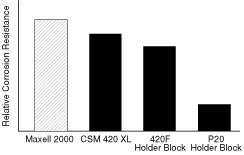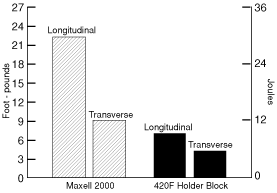
(AISI 414 Modified)
| Typical Chemistry | |
| Carbon | 0.03% |
| Chromium | 12.50% |
| Nickel | 2.75% |
| Molybdenum | 0.30% |
| Sulfur | 0.12% |
| Typical Applications | |
| Holder Blocks | |
| Backer Plates | |
| Molds not requiring #1 or #2 finish | |
- Hardening
Maxel 2000 is supplied in the prehardened condition, at about 35/39 HRC. Further heat treatment is not required. For more information concerning annealing and heat treating this grade, consult individual data sheet or a Crucible representative.
Surface Treatment
Gas or ion nitriding decreases the corrosion resistance of stainless steels, and is not recommended. Standard chrome or nickel plating may be used to enhance corrosion protection if desired.
Annealing
Maxel 2000 is intended for use in the as-supplied condition. For more information concerning annealing or heat treating this grade, consult individual data sheet, or a Crucible representative.
Welding
Use 414 or 410 filler material. Preheat to 500/700F. Maintain over 500F during welding. Cool to 150F after welding. Temper 500F 2 hours.
Corrosion Resistance
In most environments, Maxel 2000 is more resistant to rust and chemical attack than conventional stainless holder block or even 420 mold steel. It resists rusting caused by condensation or cooling water, as well as many acidic molding environments. For more severe environments, the maximum corrosion protection of CSM 21 mold steel may be required.


|
|
||||
|
Strength KSI |
Strength KSI |
% |
% |
|
|
|
||||
|
|
|
|
|
|
|
|
|
|
|
|
|
|
||||

Due to its low carbon content, Maxel 2000 is tougher than other stainless holder block. In fact, it is tougher in its worst (transverse) orientation than traditional material is in its best (longitudinal) orientation, thus providing a tougher tool, no matter what your mold base design requires.
Physical Properties
Modulus of Elasticity ...................................................................29 psi x 106
Density ..............................................................................................0.28 lb/in3
Thermal Conductivity .............200F...................................... 15 BTU/hr/ft/°F
Thermal Expansion
RT-200F................................................................. 5.8 X 10-6 in./in./°F
RT-400F ................................................................. 6.0 X 10-6 in./in./°F
RT-600F ................................................................. 6.1 X 10-6 in./in./°F